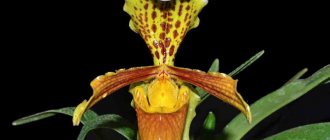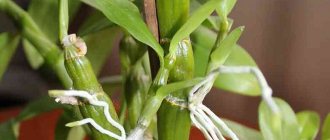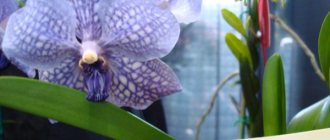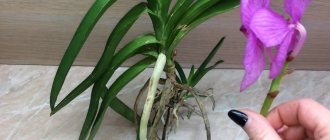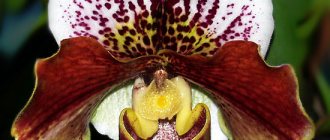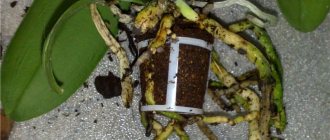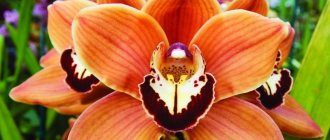Many lovers of indoor flowers are simply attracted to orchids - unusual flowers in shape and color, growing on a support. The Lady's slipper orchid variety is quite common.
Its flower is very similar to a small lady's slipper . But her charm lies not only in this. The delicate velvety color and spots on the leaves add exoticism to its appearance.
To successfully grow a tropical orchid, you need to create an environment close to its natural growth environment. The scientific name of the lady's slipper orchid is paphiopedilum . Many varieties of orchids require the same development conditions, but with Paphiopedilum everything is different.
Each type of paphiopedilum requires special care.
This type of orchid contains many varieties, each of which requires certain maintenance conditions . Some grow on rocky terrain, while others thrive in the ground. The composition of the soil for one or another subspecies is also different. Let's learn more about proper care of the Lady's Slipper orchid at home.
Optimal growing conditions
Suitable temperature
In the group of this variety there are warm- and cold-loving varieties. They can be recognized by the color of the flower:
- Bright inflorescences characterize heat-loving varieties;
- Elongated leaves with an intense green color are a cold-loving species.
Before the lovely paphiopedilum blooms, it is necessary to recreate a dormant period with an optimal air temperature of 10-15 degrees. If the accepted temperature fluctuations are not created, then flowering should not be expected.
This orchid is very susceptible to changes . For optimal growth and vegetation, temperature fluctuations can range from 18 to 25 degrees:
- In winter, the temperature should not fall below 10 degrees;
- In summer, do not rise to 33.
Comfortable air humidity level
Paphiopedilum loves moist air without foliar spraying. Optimal humidity is from 45 to 70%. If drops of water fall on the fragile leaves, unsightly spots will form on them.
We maintain a high level of humidity with expanded clay placed in a tray. At the same time, make sure that the bottom of the flower does not touch the water poured into the pan. For this purpose, a pot with a growing paphiopedilum is placed on an inverted saucer of a tray.
Advice! You can increase the humidity in your apartment air using a modern nebulizer.
Room illumination level
This type of orchid loves diffused light ; they cannot stand direct rays of the sun. On the south window, the delicate shoe is slightly shaded. It is also not recommended to keep orchids outside the window, since then they will require 12-hour lighting.
Current lighting conditions are changed gradually so that the perennial has time to adapt to the new environment. We move them from shade to sun every day for 3 weeks.
Attention! If the leaves of paphiopedilum take on a reddish color, then it indicates a strong degree of illumination and the plant requires shading.
Accommodation at home
The optimal place to place an orchid is home window sills :
- Northeastern;
- Eastern;
- And western windows.
The Lady's Slipper orchid does not need to be placed on a south window.
Some subspecies also feel great in the northern part of the house. The room where the perennial plant is kept requires frequent ventilation; in the summer it is placed in the garden .
To start flowering
To ensure the orchid blooms lushly, it is necessary to provide it with 16 hours of daylight. This can be done using a fluorescent lamp . If there is a lack of light, it reduces the level of photosynthesis; artificial lighting will help speed up the onset of flowering.
To increase the flow of light, wash the window frames , wipe the dust from the leaves, and place the perennial in a room with light walls and the same ceiling.
Choosing a site for growing cypripedium
The plant does not grow well in bright sun. It is advisable to choose a place for it where direct sunlight is present in the morning for an hour and a half, no more, and in the evening for the same amount. A bed under the scattered crown of deciduous trees is suitable, but not fruit trees: when they ripen, the fruits fall to the ground and damage the flowers.
The area should be flat, without low spots where puddles stagnate after rains and can cause rotting of the orchid root system. The soil needs to be loose and well permeable to air. Acidity is allowed within 6.5-7.5. Fertilized “fat” garden soil is not suitable for growing cypripedium orchids.
Features of care
First steps after acquisition: transplantation
After purchasing, you need to carefully examine the orchid to identify areas damaged by disease or pests. After purchase, the florist performs the following manipulations with the orchid:
- Place the newly acquired plant separately from other inhabitants of indoor plants. After this, you can safely introduce the new orchid to your neighbors;
- If you find bark with a white coating in a pot of paphiopedilum, you should throw it away immediately;
- Do not immediately expose the perennial to the sun, accustom it gradually;
- If there are no drainage holes in the pot, they can be pierced with a hot nail;
- At the beginning of adaptation, it is better not to bother the orchid by replanting it immediately after acquisition; it is better to wait until it grows;
- To maintain moisture, wipe the leaves with a moistened cotton pad.
All these recommendations will help the orchid quickly adapt to the new reality.
Watering and fertilizing
Immediately after purchasing, we do not rush to water the orchid; we wait 7 days for the soil to dry completely . For the Lady's slipper orchid, it is important to adhere to the optimal watering regime and not allow the roots to dry out or rot, because the perennial simply cannot tolerate this.
The frequency of watering depends on:
- Selected soil;
- And the degree of air humidity.
We water the perennial with settled water with a minimum salt content, this is very critical for it. We water the plant in the morning so that all the droplets of water in the sinuses dry out.
Advice! To avoid problems with the development of various fungal diseases, simply blotting the plant's rosette with a napkin if water gets there.
Lady's slipper is susceptible to excess feeding, so this is not done so often - 2 times a month. At the same time, we alternate organic and mineral fertilizers, adding half the dose taken.
It is necessary to feed the orchid during active growth.
The plant needs to be fed only during active growth ; it is not required during abundant flowering. In winter, the perennial needs feeding once a month. To prevent increased formation of salts due to the application of fertilizers, we wash the substrate monthly.
Ways to stimulate flowering
In order for paphiopedilum to bloom, it is important to observe changes in room temperature. For varieties with leaves of an intense green tone, for beautiful flowering it is important to observe a certain temperature regime , which differs during the day and at night.
These species prefer the heat of the day combined with the coolness of the night:
- During the daytime, the air temperature should be within 24 degrees;
- At night - from 10 to 12 degrees.
Varieties that bloom variegatedly require warmer air at night - from 15 to 17 degrees. At the same time, we make sure that the room is not too hot, otherwise there is a risk of losing the fragile orchid forever.
Lady's slipper will delight you with magnificent flowers. Follow the basics of caring for it, and the result in the form of lovely flowers will not be long in coming. To stimulate flowering, you need to follow the watering schedule, do not allow the soil to dry out, or water to stagnate in the outlet under the pot.
Trimming
After a long period of dormancy, the beautiful Paphiopedilum begins its flowering period . A peduncle appears from the middle of a strong rosette. Depending on the shape of the perennial, there may be only one flower on it.
It will stand on the peduncle for 2-4 months. With proper care, the plant will please the eye for 6-7 months. It is important for novice gardeners to know that one peduncle blooms only once .
It is for this reason that in varieties with one flower the strong peduncle is cut off, while in varieties with another beautiful flowering the stem is left until the end of flowering.
Nuances during a period of long rest
A dormant period is usually observed for varieties of the beautiful orchid with spotted leaves. This period is necessary, because it is followed by lush flowering. Rest for Venus's slipper begins in November.
Careful care for it during this period is simple: maintaining the air temperature at 15 degrees with periodic spraying of the soil substrate with water without fertilizing . After the peduncle emerges, this period ends.
Prevention of diseases and pests
The Paphiopedilum orchid has leaves and roots that are susceptible to various diseases and pests. During its care, leaf blades often die off . Depending on the symptoms, there are several objective reasons for this phenomenon:
- The leaves first acquire a yellow color, then turn brown - the result of natural death;
- The top of the leaf becomes almost black, then the entire edge of the plate darkens - this indicates that the plant is oversaturated with fertilizer or is infected with a dangerous fungus.
The mold fungus botrytis causes a fragile orchid to shed unopened buds. This may be due to lower air temperatures at night and increased humidity.
There are many pests of the Lady's slipper orchid.
Among the dangerous pests, the lush Lady's slipper orchid is most often attacked by :
- Flat beetle mites;
- Mealybugs;
- And scale insects.
Botanical description
The herbaceous perennial translated from Latin (Cupripedium calceolus) means “Cupridium’s slipper.” The plant belongs to the monocot class. It reaches a height of 15-25 cm, the leaves are ellipsoid, the rhizome is creeping horizontal. Usually it produces 1-2 flowers of an unusual configuration, where one petal is curved with a “protruding lip” in the form of a shoe, and the rest are wrapped around it, as if with ribbons, slightly twisting.
Flowering begins in mid-May and lasts a whole month. Nature made sure that the plant did not go unnoticed among other representatives of the forest flora, and rewarded it with brightly colored flowers and a pleasant, refined aroma. The structure of the bud is designed according to the principle of a trap so that small insects can perform the function of pollinators. Attracted by the delicate scent, they land on the smooth border of the bud and fall down. At the base of the large petal there are succulent hairs, on which pollen remains, carried on their legs by flies and bugs from other flowers. Desperately looking for a way out, the insects “string” pollen from the lady’s slipper onto their pile and, finally slipping out to freedom, fly on.
Related article:
Flowers that bloom in spring
Thanks to its striking color, the flower stands out noticeably against the background of the rest of the forest vegetation, which literally begs the attention of herbivores: hares, roe deer, moose, etc. But they are unable to feast on the beautiful “bait” - the leaves contain bitter juice, which is also poisonous.
The fruits ripen in a brown box, visually reminiscent of a cucumber. This “storage”, about 3 cm long, contains several thousand seeds. In autumn, the upper greenery withers and dies, and the root system goes into dormancy. The new growing season begins in the spring after the soil warms up. Green shoots emerge from the ground, continuing their development.
Note to the florist: The most beautiful varieties of dahlias
Landing Features
The success of growing the Lady's slipper orchid depends on the correct soil substrate . As the basis for the soil composition for paphiopedilum, natural pine bark and peat are used for planting seedlings in a ratio of 3:1.
In addition to the main composition, flower growers add a small number :
- Charcoal;
- Natural river sand;
- Natural expanded clay;
- High-quality sphagnum moss to preserve life-giving moisture.
In terms of acidity, the soil composition for orchids should be :
- Neutral;
- Or slightly acidic.
Pot
To grow this variety of orchids take :
- Plastic;
- Or clay containers.
The walls of clay dishes have pores that can allow air to pass through to the roots of the perennial. Transparent plastic makes it convenient to monitor susceptible root systems.
Due to oversaturation with moisture, the walls of a transparent pot may become covered with green mold, so it is additionally moved to a flower pot. Plastic containers are very convenient for seasonal replanting ; the plant can be easily removed from it. The neck of the plastic pot should be wider than the base.
Attention! The bottom of the flowerpot should have a hole for draining water.
Technology
- Carefully remove the plant;
- We inspect the root system;
- We remove rotten roots;
- We carefully treat the cuts with crushed coal.
When replanting, take into account the height of the transplanted plant.
A perennial planted too high will simply have roots that hang and stop developing. A perennial planted too low can cause the rosette to rot. Compacting the substrate is not required here.
A thorough inspection of the roots and substrate should be done every 6 months . For this purpose, the roots are removed from the container and their condition is carefully assessed.
Timing and technology
A mature perennial is replanted annually, but a young orchid needs to be replanted every 2-3 years. To undergo a transplant, at least one of the following :
- 8 or more sockets are formed in a plastic container;
- The new young shoot has become stronger and needs to be divided;
- After flowering ends;
- If the soil substrate is too saline, which negatively affects the general condition of the perennial;
- If spring has arrived, this is the optimal time to replant any perennials.
Some gardeners change the soil every 8 months. Replanting an orchid during flowering is impossible , as this negatively affects the state of flowering.
The best hybrids of the lady's slipper
The most popular Cypripedium hybrids bred by Michael Weinert are Gisela, Anna, Emil and Hank Small. Let's talk about each of them in more detail.
Shoe Anna
Anna is a real find for flower growers who don’t have time to painstakingly care for their flowerbeds. This shoe grows quickly and does not bring any trouble.
Lady's slipper Anna
The hybrid boasts brightly colored inflorescences. Plant height is 30-40 cm. Flowering occurs in the second half of May.
Lady's slipper Anna
The plant's winter hardiness is very high, just like other hybrids of this selection.
Gisela's slipper
Hybrid Gisela, like Anna, is good for beginner gardeners who have no experience in growing garden orchids. In a few years, the plant will grow into large clumps 30-40 cm high.
Lady's slipper Gisela
This slipper blooms in May. The color of the flowers is pinkish-purple.
Lady's slipper Gisela
Lady's slipper Gisela
Even in winters with little snow, it can withstand frosts down to –30°C. In order to tolerate such temperatures, the plant only needs a small snow shelter.
Lady's slipper Gisela
Lady's slipper Gisela
Shoe Emil
This graceful cypripedium reaches 40-50 cm in height. It amazes with the spectacular yellow-burgundy color of the inflorescences.
Lady's slipper Emil
Outwardly, Emil resembles the European and North American species of slippers, but is much more winter-hardy and unpretentious.
Lady's slipper Emil
Plants of this hybrid bloom in mid-May. Sometimes two inflorescences are formed on one peduncle at once.
Lady's slipper Emil
How to revive a perennial without roots?
If your paphiopedilum orchid has practically no roots left, then you need to start restoring them as quickly as possible. Small drying of the soil substrate stimulates the formation of roots , this fact has been noticed by many gardeners trying to restore orchids.
Daily spraying of the soil surface and the bark fraction on the soil gives results. To restore an orchid, you do not need to create special conditions for it or place it in a greenhouse. All these measures will give a good result after 2 months, when the young roots get stronger.
Every third watering we feed the diseased plant with fertilizer for lush orchids. “Rainbow” is suitable for these purposes. In hot months, water it more often .
Interesting Facts
- It turns out that orchid seeds germinate only thanks to special fungi that naturally penetrate the tissues of the embryo;
- If other varieties of orchids can begin to bloom 2-3 years after germination of the seed, then the Lady's slipper may take as long as 15 years;
- It has protective functions , for example, it is saved from being eaten by animals by poisonous juice;
- Venus's slippers are long-lived and can grow for even 100 years!
- In 1984 they were listed in the Red Book of the USSR.
Reproduction methods
This variety of orchids can only be propagated by dividing the bush . When many strong rosettes have appeared, division can begin. If there are at least 3 rosettes growing in the pot, then it can already be planted.
There are several ways to propagate orchids.
Divided orchids are placed in the shade, continuing to regularly spray the soil mixture until active shoot growth . This is followed by the usual care of the perennial.
Bloom
Proper care involves the annual flowering of the Lady's Slipper. Most often this period occurs in autumn-winter. It is very simple to determine that a flower is fully prepared and will soon begin to delight with inflorescences - a stop leaf appears from the growing point.
in size than standard leaves and usually does not grow further. This means that the orchid will soon begin to actively bloom.
This moment is inevitable if all recommendations were taken into account when growing an orchid and favorable conditions were provided throughout the year. When the stop leaf becomes compacted, a bud appears from it.
IMPORTANT! During the flowering period, the orchid must not be disturbed, especially moved to another place. After all, if a plant begins to bloom, then the conditions for this are quite favorable and any changes can only do harm.
Usually, the Lady's Slipper does not hibernate, but after flowering it still needs a short rest . To do this, lower the temperature slightly (15-18 degrees) and reduce the flow of moisture.
As soon as the plant begins to delight with a new bud, the rest period is over and now the previous conditions , that is, raise the temperature, resume watering and fertilizing.
Main growing problems
If Paphiopedilum is grown from a single rosette, then it is incredibly difficult for it to grow leaf mass. Rotten roots can be from :
- Incorrect watering regime;
- Overfeeding;
- Poor quality soil composition.
You should not rush to remove a faded rosette, because the life and development of new rosettes depends on it. Paphiopedilum acquires its own roots only in the second year of life.
When the neck is deeply deepened, it begins to come into contact with a moist substrate , which negatively affects the development of the flower.
You need to be extremely careful with the leaf blades of the orchid, because direct rays of the sun can burn them, so brown spots can form on them. To protect the plant from spider mites, wipe its leaves once a week with a damp cloth .
Lack of flowering may also indicate non-compliance with irrigation regime and temperature changes. The dying off of faded buds is a normal renewal process and should not be alarmed.
Habitat
In nature, lady's slipper grows in Asia, Europe, and Latin America. On the map of Russia it was “marked” in Western and Eastern Siberia, the Far Eastern region and the European region, as well as in Crimea and the Caucasus. In fact, the plant has adapted to almost all living conditions, from the tropics and subtropics to the forest-tundra.
Most often, it prefers to grow in deciduous forests (oak, beech, aspen), birch groves, choosing shady glades and avoiding too active sunlight. In the coniferous taiga, the slipper of Venus can also be seen, but this is rather the exception than the rule. The plant is quite picky about soils; fertile areas rich in humus and lime, well moistened, but not muddy, are suitable for it. Although sometimes the flower is found in swampy areas, again, this is rare.
Related article:
Frost-resistant rhododendrons and wintering bushes
Some species are so frost-resistant that they can even withstand extreme cold. The plant reacts sharply to significant changes in the environment, even to the point of death. It is especially sensitive to sudden changes in temperature, changes in humidity levels, light levels, and the number of pollinating insects. Naturally, widespread deforestation also adds problems. Flowers do not survive in bare areas; only rapidly growing undergrowth can save the population.
Due to man's irrational use of the environment, the continued existence of the plant in its natural environment is under threat. Today it can only be found in remote dense forests, as well as in nature reserves, arboretums and botanical gardens. Growing it in decorative conditions is difficult due to its capriciousness to soils, climate and other factors.
Diseases and pests
Particularly dangerous is brown leaf spot, which occurs from :
- Excessive moisture;
- Drying out;
- After using a low-quality substrate.
In order to prevent dangerous diseases, the following is carried out :
- Disinfection of the pot;
- And treating the perennial with phytosporin.
If affected leaves are found, they are destroyed, and the pot with the growing orchid is placed in a well-ventilated place. The perennial is treated with a fungicide .
Of the pests that attack perennials, the most dangerous are :
- Aphid;
- Mealybug;
- Common scale insect;
- Slugs.
You need to deal with them in the standard way. Plants and soil substrate are treated with a prepared solution of karbofos, the concentration level here is 0.1% -0.2%. If there are slugs or snails, formaldehyde is added to the solution.
When growing this orchid variety indoors, foliage problems
- Elongated and brightening leaf blades are the result of a lack of light or nitrogen deficiency;
- Elongated leaves of a rich green tone, falling buds indicate an excess of nitrogen, we stop adding this element and add potassium instead;
- The leaves take on a reddish tint - you need to place the flower in the shade to eliminate the possibility of burns;
- When the top leaves are crushed, the perennial is replanted; if the root system is poorly developed, at elevated temperatures in the summer heat the perennial should be fed;
- Dying of young roots - increased concentration of soil acidity or excess fertilizer, the plant is affected by snails;
- Drying of young shoots is a lack of moisture; frequent spraying of the substrate will help get rid of it.
If young strong shoots begin to turn black at the base and die, we destroy the dead parts and treat the plant with copper chloride . In this case, you need to ensure that drops of moisture do not fall into the base of the young rosette.
Advice! If the plant is affected by aphids, it must be treated with an insecticide.
Caring for cypripedium in open ground conditions
Caring for a lady's slipper is simple: the flower does not require the vigilance of the florist. The main thing is to remember the superficial root system of the plant and loosen the soil around it carefully so as not to damage the fragile roots. It is better to remove small weeds by hand, but large ones, which, by tearing them out, can uproot a large lump of earth along with the roots of the shoe, try to cut them off at the root with pruning shears.
In dry weather, cypripedium is regularly watered; the plant loves moisture. However, she dies from her excess. You should be very careful with fertilizer. Lady's slipper is fed only in the spring, and the dose of the solution is taken equal to ¼ of that indicated by the manufacturer of the drug on the packaging. It is not recommended to fertilize the flower often; this provokes the appearance of many young shoots that do not have time to form and mature for wintering before the beginning of winter. They greatly weaken the mother plant, so much so that the flower may not survive the winter.
It’s a good idea to pay attention to fencing cypripedium plantings to protect them from animals. Sometimes a low metal mesh is enough to block the path of those who are capable of simply breaking the stems, and those who feed on the succulent foliage of a garden orchid.
